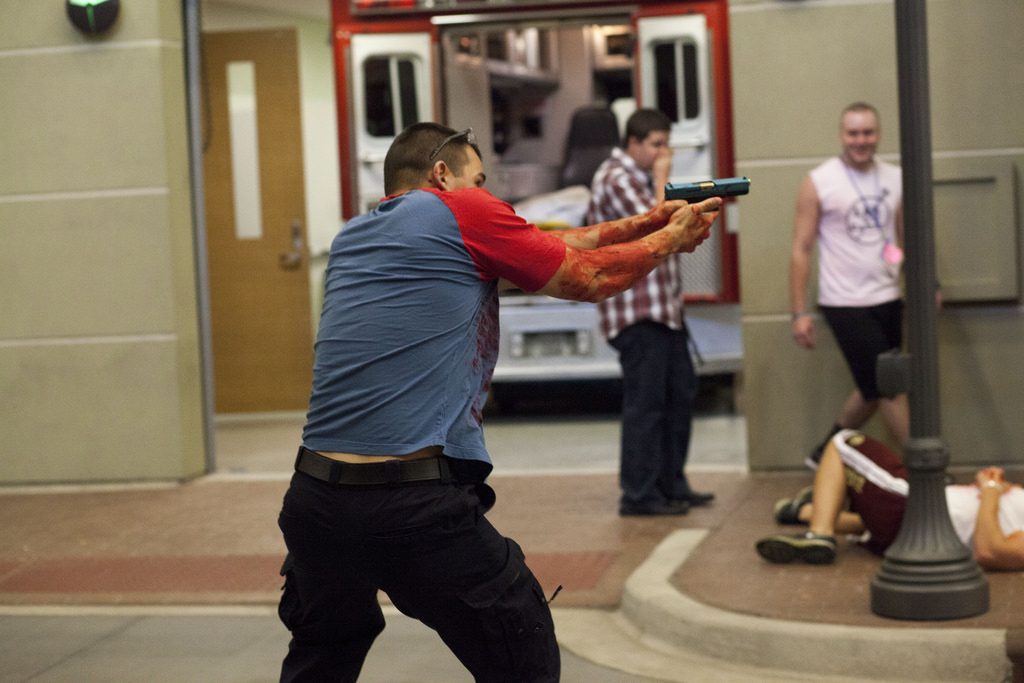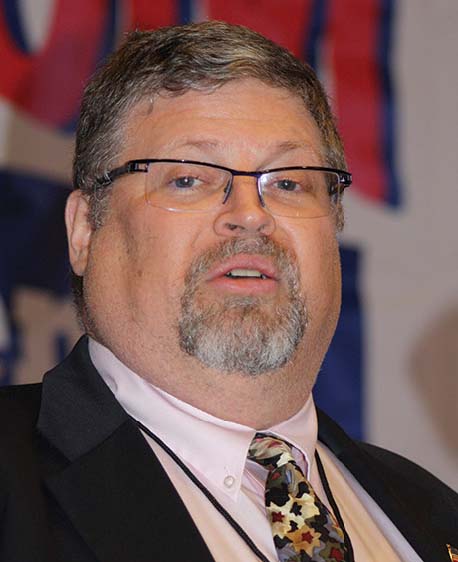
(from aegis.com)
[Ed: Dr. Edeen, our Membership Director, is a strong proponent of self-rescue, including shooting back, in medical settings that are so vulnerable to mass casualty attacks. He puts his time and money where his mouth is, and this report is one result.]
I recently traveled to the Firearms Academy of Seattle (FAS) in Onalaska, Washington, to participate in their three-day Active Shooter Interdiction course. The course was sponsored by Paul Lathrop and the Polite Society Podcast.
Much to my delight, I found out that Sean Brodale, DO, Outreach Director for DRGO, was going to be one of the 12 participants in class. We reported to FAS just before 0900 on a crisp, sunny morning Tuesday July 24. Massad Ayoob and his wife Gail were also students in this class. I had taken Mas’s fourth level class, MAG 180, in Ripon, Wisconsin, just a month earlier. I was looking forward to training with Mas and Gail as fellow students. Other students of note were Paul Lathrop and Kat Ainsworth, Outdoor writer and Hunting Editor at The Truth About Guns.
The course was taught by Marty Hayes, the owner of FAS and two of his instructors, Belle McCormack and Erik Knise. The stated goal of the class was to teach those people who want to train to be at one with the gun so that they could assess and solve problems in a 360-degree environment. We would train to the worst case scenarios. We then proceeded to list approximately twenty adverse conditions that we might have to deal with during our encounters. These include multiple attackers, no cover, low light, varying distances, one-handed operation, moving attackers, innocent bystanders and hostages among many others.
After the safety brief, we proceeded to the low light range. Our first day was a defensive handgun tune-up and assessment. Our first exercise was to determine our natural point of aim (NPOA). We first used our sights and then had our sights taped over. After getting our NPOAs sorted out, we transitioned to the outdoor range and worked on different reloading techniques. We then assessed our shooting by taking a single shot on target. If we hit the A-zone, we would take a step back and shoot again. If we missed, we took the step back and dry fired to work on trigger control.
FAS is equipped with moving targets on a pulley system that move from right to left and vice versa at various speeds. We received instruction in various techniques of shooting moving targets. These include tracking, overtaking, trapping and ambush.
After practicing these techniques, we were offered the opportunity to take the FAS Handgun Master test. It involved shooting 6 rounds in the A-zone of an IPSC target at 15 yards in 30 seconds, shooting each of three targets with one shot, reload, repeat shooting the three targets with one shot each, another reload and then a single target shot in A and C zones from 7 yards in 12 seconds. Next was to shoot six rounds in six seconds from the holster, strong hand only from 4 yards and the same from 45-degree low ready, weak hand only. The fourth stage was shooting a right to left mover with three shots at 7 yards and then the same left to right, the A-zone only counting. The last stage was at the low light range. One shot to hit each of three targets, in the A and C zones, in 3.5 seconds, four times. I was one of four people to qualify.
Day two started in the classroom with a lecture regarding targeting active shooters. We are usually taught to shoot for center of mass. However, with the active shooter, we need an immediate stop. That translates to hits in the deep brain, brain stem, upper spinal cord or major blood vessels to the brain in the upper chest. We might need to take a shot at 50+ yards and then move closer. How close do you need to be to make to get a hit? How close to get a stop? We were taught the Sul position for movement in a crowd and in a 360° degree environment.
Then we proceeded to the range to do several exercises designed to stress trigger control and precise shooting. After that, we worked on shooting around cover at 25 yards from both strong and weak sides of a support post. We then moved to the 50 yard range. This was set up with steel targets: an IPSC silhouette, an 18-inch disc and an 8-inch disc. Single barrels were set up at 11 and 20 yards. Two stacked barrels were set up at 25, 33, 43 and 50 yards. The stacked barrels were offset to force you to shoot on both weak and strong sides.
We started shooting the 8-inch disc at the closest two distances. At the medium distances we shot the 18-inch disc, and at the farthest distances we shot the silhouette. We used competition to add stress and performance pressure. We also added kneeling, seated, weak side, strong side and one-handed shooting to the mix. We all noted improved consistency in our distance shooting by the end of the day. We finished our range session by shooting movers at 25 yards using barrels for cover.
We finished up the day with a recorded video lecture from Andy Brown. He described the active shooter event at the hospital at Fairchild Air Force Base in Spokane, WA in 1994. He was on the base security force, responded on his patrol bicycle, and stopped the killer with his fourth shot from 72 yards. His book, Warnings Unheeded, describes the events surrounding the active killer event and, four days later, the crash of a B-52 bomber from the base. In both cases, warnings were not acted upon and the tragedies were not prevented.
The final day began at the low light range. We started in the Sul position, and while moving forward, we were given a signal to begin shooting while continuing to move forward toward the target. We also used hand held flashlights to illuminate the targets, shoot, and move. We then went outside and had a one on one competition shooting steel spinners. Then it was back out to the range to shoot movers from 12 and 20 yards. We did tracking drills with shooting on signal and when the targets stopped. It was then back to the steel range to do head shot drills from 11 yards. Draw, knee then shoot. Our last steel range exercise involved shooting and retreating with the gun in the Sul position from several distances.
The final competition involved taking a single shot from each distance. The silhouette was 1 point, 18” disc was 2 and the 8” disc was 3 points. A miss was 0. Each team had 4 shooters. Each shooter had to choose which target he or she felt able to hit at each distance, then execute the shot. The maximum score was 18. It was an excellent way to assess each shooter’s skill and to assess our progress.
We finished up the day doing realistic scenarios. We addressed two active shooter scenarios on the range with movers. In the first, there was an active shooter in a school yard with multiple bad guys and a hostage. The second scenario involved a family member at an airport, where there were bomb threat and an active shooter. It required moving, assessing information, using cover, and making good hits. The day ended with four more scenarios using air soft pistols. Each scenario allowed interaction with actors, and required decision making that included solving shoot versus no-shoot judgments.
The class exceeded my expectations. My distance shooting not only improved, but I also developed a good sense of my ability to make shots in an active killer situation. I was introduced to moving targets and to the concept of not just getting hits, but good ones. The scenarios made me analyze, think and act based on my observations and training.
With this Active Shooter Interdiction course, the Firearms Academy of Seattle has created the benchmark for training to take out active shooters. The scenarios are as realistic as possible, and thoroughly test the skills gained during the preceding instructional part of the course. The opportunity to take the FAS Handgun Mastery test was icing on the cake.
Set aside three days to go and experience this exceptional course. Highly recommended!
 —Dr. John Edeen is a pediatric orthopedic surgeon in San Antonio, TX and is active in seeking the right to carry for qualified hospital staff. He is DRGO’s Membership Director.
—Dr. John Edeen is a pediatric orthopedic surgeon in San Antonio, TX and is active in seeking the right to carry for qualified hospital staff. He is DRGO’s Membership Director.
